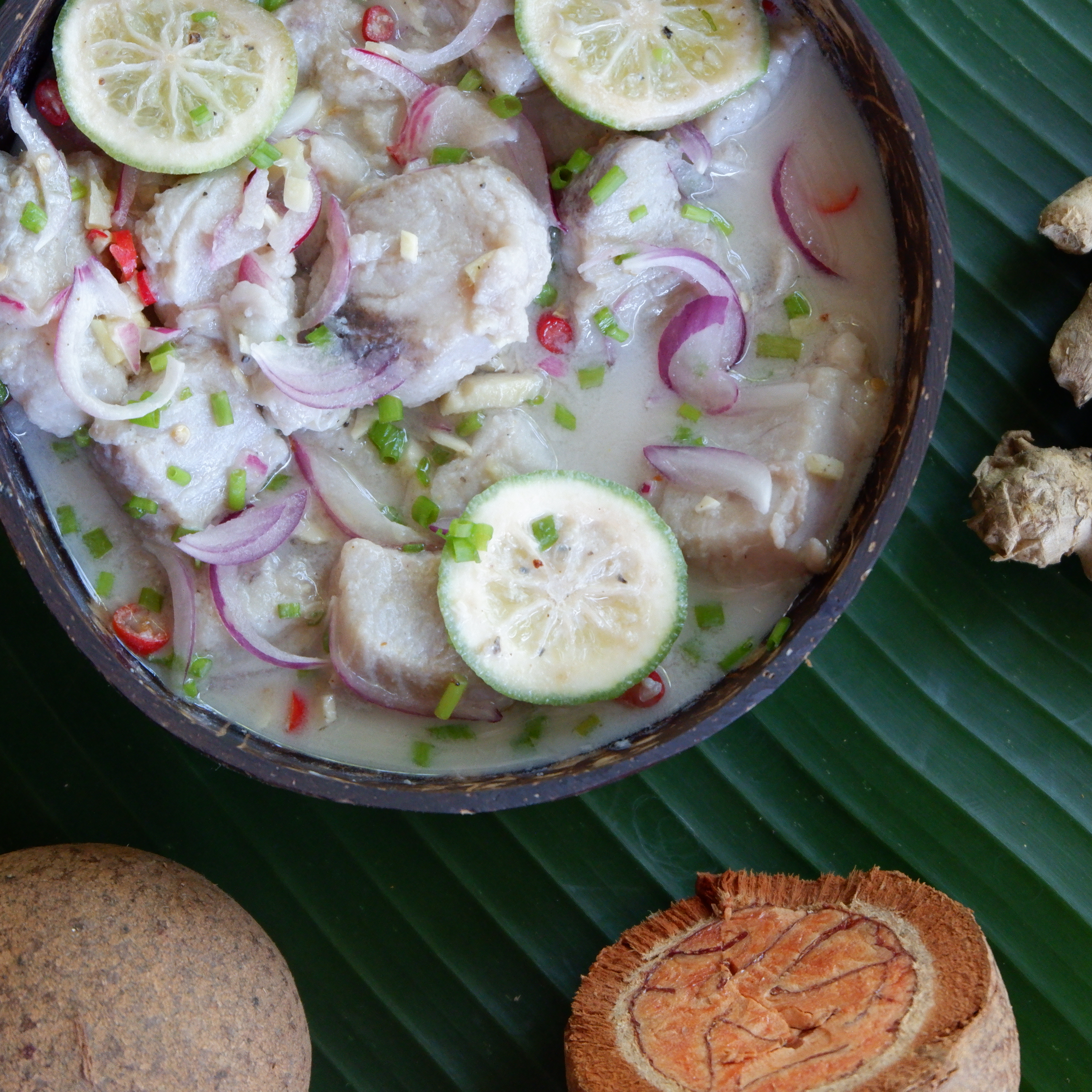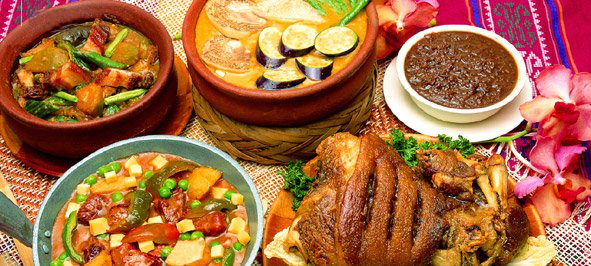|
Ginataang Isda
''Ginataang isda'' is a Filipino fish stew made from Fish as food, fish and leafy vegetables in coconut milk with garlic, ginger, onion, ''patis (sauce), patis'' (fish sauce) or ''bagoong alamang'' (shrimp paste), and salt and pepper. It is a type of ''ginataan''. A common version of the dish, known as ''ginataang paksiw na isda'' or ''paksiw na isda sa gata'', is additionally soured with vinegar (a cooking method known as ''paksiw''). ''Ginataang isda'' is a type of ''ginataan''. Names ''Ginataang isda'' is a more generalized name meaning "fish in coconut milk". It is more common, however, to name the dish based on the type of fish used. The typical fish used in ''ginataang isda'' include: ''ginataang tilapia'' (tilapia), ''ginataang tambakol'' (yellowfin tuna), ''ginataang galunggong'' (blackfin scad), and ''ginataang tulingan'' (skipjack tuna). Description Aside from fish, the secondary ingredient of ''ginataang isda'' are leafy vegetables. These are most commonly ''pechay'', ... [...More Info...] [...Related Items...] OR: [Wikipedia] [Google] [Baidu] |
Tuna
A tuna (: tunas or tuna) is a saltwater fish that belongs to the tribe Thunnini, a subgrouping of the Scombridae ( mackerel) family. The Thunnini comprise 15 species across five genera, the sizes of which vary greatly, ranging from the bullet tuna (max length: , weight: ) up to the Atlantic bluefin tuna (max length: , weight: ), which averages and is believed to live up to 50 years. Tuna, opah, and mackerel sharks are the only species of fish that can maintain a body temperature higher than that of the surrounding water. An active and agile predator, the tuna has a sleek, streamlined body, and is among the fastest-swimming pelagic fish—the yellowfin tuna, for example, is capable of speeds of up to . Greatly inflated speeds can be found in early scientific reports and are still widely reported in the popular literature. Found in warm seas, the tuna is commercially fished extensively as a food fish, and is popular as a bluewater game fish. As a result of overfishi ... [...More Info...] [...Related Items...] OR: [Wikipedia] [Google] [Baidu] |
Fish
A fish (: fish or fishes) is an aquatic animal, aquatic, Anamniotes, anamniotic, gill-bearing vertebrate animal with swimming fish fin, fins and craniate, a hard skull, but lacking limb (anatomy), limbs with digit (anatomy), digits. Fish can be grouped into the more basal (phylogenetics), basal jawless fish and the more common jawed fish, the latter including all extant taxon, living cartilaginous fish, cartilaginous and bony fish, as well as the extinct placoderms and acanthodians. In a break to the long tradition of grouping all fish into a single Class (biology), class (Pisces), modern phylogenetics views fish as a paraphyletic group. Most fish are ectotherm, cold-blooded, their body temperature varying with the surrounding water, though some large nekton, active swimmers like white shark and tuna can hold a higher core temperature. Many fish can communication in aquatic animals#Acoustic, communicate acoustically with each other, such as during courtship displays. The stud ... [...More Info...] [...Related Items...] OR: [Wikipedia] [Google] [Baidu] |
Kinilaw
''Kinilaw'' ( or , literally "eaten raw") is a raw seafood dish and preparation method native to the Philippines. It is more accurately a cooking process that relies on vinegar and acidic fruit juices (usually citrus) to denature the ingredients, rather than a dish, as it can also be used to prepare meat and vegetables. Kinilaw dishes are usually eaten as appetizers before a meal, or as finger food () with alcoholic drinks. Kinilaw is also sometimes called ''kilawin'', especially in the northern Philippines, but the term ''kilawin'' more commonly applies to a similar lightly grilled meat dish. Description The most common kinilaw dish is ''kinilaw na isda'' ("fish ''kinilaw''"), prepared using raw cubed fish mixed with vinegar (usually coconut vinegar or cane vinegar) as the primary denaturing agent; along with a souring agent to enhance the tartness like ''calamansi'', '' dayap'' (key lime), '' biasong'' (also known as ''suhà''), '' kamias'' (bilimbi), tamarind, green ... [...More Info...] [...Related Items...] OR: [Wikipedia] [Google] [Baidu] |
Linarang
''Linarang'', also known as ''larang'' or ''nilarang'', is a Filipino fish stew originating from the Central Visayas islands. It is made with fish in a spicy and sour coconut milk-based broth with garlic, red onions, tomatoes, fermented black beans (''tausi''), chilis, and sour fruits. Etymology The name ''linarang'' or ''nilarang'' (lit. "done as ''larang''"), is the affixed form of the Cebuano verb ''larang'', meaning "to stew with coconut milk and spices". The word is originally a synonym of the ''ginataan'' cooking process (''ginat-an'' or ''tinunoan'' in Cebuano), but has come to refer exclusively to this particular dish. Description ''Linarang'' is prepared by first sautéing the fish with garlic, red onions, and tomatoes. It is then added to a broth with fermented black beans (''tausi''), chilis, and a souring agent. The souring agent is usually bilimbi (''iba''), unripe mangoes, or tamarind (''sambag''), but can also be any sour fruit. Variations ''Linarang'' can va ... [...More Info...] [...Related Items...] OR: [Wikipedia] [Google] [Baidu] |
Filipino Cuisine
Filipino cuisine is composed of the cuisines of more than a hundred distinct Ethnic groups in the Philippines, ethnolinguistic groups found throughout the Philippines, Philippine archipelago. A majority of mainstream Filipino dishes that comprise Filipino cuisine are from the food traditions of various ethnolinguistic groups and tribes of the archipelago, including the Ilocano people, Ilocano, Pangasinan people, Pangasinan, Kapampangan people, Kapampangan, Tagalog people, Tagalog, Bicolano people, Bicolano, Visayan, Chavacano, and Maranao people, Maranao ethnolinguistic groups. The dishes associated with these groups evolved over the centuries from a largely indigenous (largely Austronesian peoples, Austronesian) base shared with maritime Southeast Asia with varied influences from Chinese cuisine, Chinese, Spanish cuisine, Spanish, and American cuisine, American cuisines, in line with the major waves of influence that had enriched the cultures of the archipelago, and adapted us ... [...More Info...] [...Related Items...] OR: [Wikipedia] [Google] [Baidu] |
Vinegar
Vinegar () is an aqueous solution of diluted acetic acid and trace compounds that may include flavorings. Vinegar typically contains from 5% to 18% acetic acid by volume. Usually, the acetic acid is produced by a double fermentation, converting simple sugars to ethanol using yeast and ethanol to acetic acid using acetic acid bacteria. Many types of vinegar are made, depending on source materials. The product is now mainly used in the culinary arts as a flavorful, acidic cooking ingredient or in pickling. Various types are used as condiments or garnishes, including balsamic vinegar and malt vinegar. As the most easily manufactured mild acid, it has a wide variety of industrial and domestic uses, including functioning as a household cleaner. Etymology The word "vinegar" arrived in Middle English from Old French (''vyn egre''; sour wine), which in turn derives from Latin: (wine) + (neuter gender of , sour). Vinegar was formerly also called . The word "acetic" derives from ... [...More Info...] [...Related Items...] OR: [Wikipedia] [Google] [Baidu] |
Coconut Cream
Coconut milk is a plant milk extracted from the grated pulp of mature coconuts. The opacity and rich taste of the milky-white liquid are due to its high oil content, most of which is saturated fat. Coconut milk is a traditional food ingredient used in Southeast Asia, Oceania, South Asia, and East Africa. It is also used for cooking in the Caribbean, Central America, northern parts of South America and West Africa, where coconuts were introduced during the colonial era. Coconut milk is differentiated into subtypes based on fat content. They can be generalized into coconut cream (or thick coconut milk) with the highest amount of fat; coconut milk (or thin coconut milk) with a maximum of around 20% fat; and coconut skim milk with negligible amounts of fat. This terminology is not always followed in commercial coconut milk sold in Western countries. Coconut milk can also be used to produce milk substitutes (differentiated as "coconut milk beverages"). These products are not the s ... [...More Info...] [...Related Items...] OR: [Wikipedia] [Google] [Baidu] |
Labuyo
''Siling labuyo'' is a small chili pepper cultivar that developed in the Philippines after the Columbian Exchange. It belongs to the species ''Capsicum frutescens'' and is characterized by triangular fruits that grow pointing upwards. The fruits and leaves are used in traditional Philippine cuisine. The fruit is pungent, ranking at 80,000 to 100,000 heat units in the Scoville Scale. The cultivar name is Tagalog, and literally translates to "wild chili." It is also known simply as ''labuyo'' or ''labuyo'' chili. Thai bird's eye chili are commonly confused with Labuyo in the Philippines, though they are cultivars of two different species, and much larger fruit. ''Siling labuyo'' is one of two common kinds of local chili found in the Philippines, the other being '' siling haba'' (a ''Capsicum annuum'' cultivar). ''Siling labuyo'' is generally accepted as the world's smallest hot pepper, as the fruit often measures a mere in length by in width. It is listed in the Ark of Taste ... [...More Info...] [...Related Items...] OR: [Wikipedia] [Google] [Baidu] |
Siling Haba
''Siling haba'' ("long chili"), ''espada'' ("sword" in Spanish), ''siling mahaba'', ''siling pangsigang'' ("chili for ''sinigang''"), ''siling Tagalog'' ("Tagalog chili"), and sometimes called green chili, finger chili or long pepper, is one of two kinds of chili common to the Philippines and Filipino cuisine, the other being '' siling labuyo''. Unlike ''siling labuyo'', it belongs to the species ''Capsicum annuum''. The ''siling haba'' fruit grows to between long, and is bright light green in color. While of moderate spiciness, it is much milder and less hot than ''siling labuyo''. It is an ingredient commonly used in Philippine cuisine, spicing up dishes like sinigang, dinuguan, pinangat, kilawin, paksiw, and sisig. See also *Bird's eye chili Bird's eye chili or Thai chili ( owing to its shape) is a chili pepper variety (botany), variety from the species ''Capsicum annuum'' that is native to Mexico. Cultivated across Southeast Asia, it is used extensively in many Asian ... [...More Info...] [...Related Items...] OR: [Wikipedia] [Google] [Baidu] |
Bitter Melon
''Momordica charantia'' (commonly called bitter melon, cerassee, goya, bitter apple, bitter gourd, bitter squash, balsam-pear, karela, karavila and many more #Uses, names listed below) is a tropical and subtropical vine of the family Cucurbitaceae, widely grown in Asia, Africa, and the Caribbean for its edible fruit. Its many variety (botany), varieties differ substantially in the shape and bitterness of the fruit. Bitter melon originated in Africa, where it was a dry-season staple food of ǃKung people, ǃKung hunter-gatherers. Wild or semi-domesticated variants spread across Asia in prehistory, and it was likely fully domesticated in Southeast Asia. It is widely used in the cuisines of East Asian cuisine, East Asia, South Asian cuisine, South Asia, and Southeast Asian cuisine, Southeast Asia. Description This herbaceous, tendril-bearing vine grows up to in length. It bears simple, Phyllotaxis, alternate leaves across, with three to seven deeply separated lobes. Each plan ... [...More Info...] [...Related Items...] OR: [Wikipedia] [Google] [Baidu] |
Cabbage
Cabbage, comprising several cultivars of '' Brassica oleracea'', is a leafy green, red (purple), or white (pale green) biennial plant grown as an annual vegetable crop for its dense-leaved heads. It is descended from the wild cabbage ( ''B. oleracea'' var. ''oleracea''), and belongs to the " cole crops" or brassicas, meaning it is closely related to broccoli and cauliflower (var. ''botrytis''); Brussels sprouts (var. ''gemmifera''); and Savoy cabbage (var. ''sabauda''). A cabbage generally weighs between . Smooth-leafed, firm-headed green cabbages are the most common, with smooth-leafed purple cabbages and crinkle-leafed savoy cabbages of both colours being rarer. Under conditions of long sunny days, such as those found at high northern latitudes in summer, cabbages can grow quite large. , the heaviest cabbage was . Cabbage heads are generally picked during the first year of the plant's life cycle, but plants intended for seed are allowed to grow a second year and m ... [...More Info...] [...Related Items...] OR: [Wikipedia] [Google] [Baidu] |










